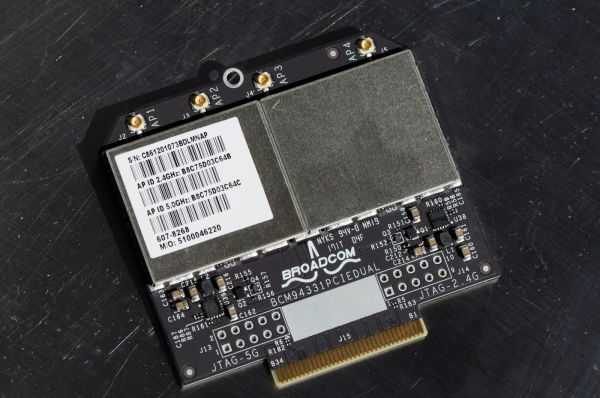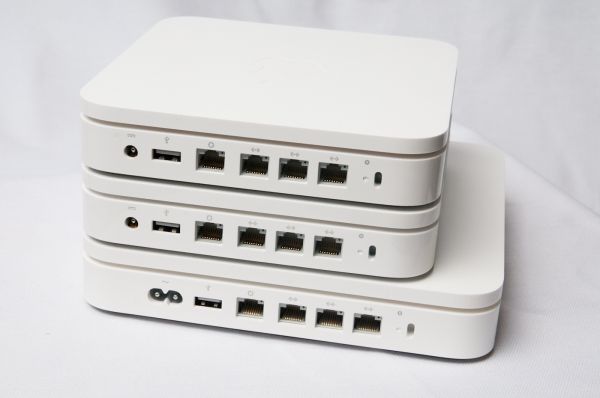Airport Extreme (5th Gen) and Time Capsule (4th Gen) Review - Faster WiFi
by Brian Klug on August 5, 2011 10:22 PM EST- Posted in
- Mac
- Airport Extreme
- Time Capsule
- WiFi
Conclusion and Final Thoughts
We’ve gone into extreme detail about the Time Capsule and Airport Extreme updates. I originally intended to have this posted with a hint of irony on WiFi day (8.02.11) but instead ended up spending that special day doing more testing and running even more instances of Iperf to make sure our numbers were solid. What’s changed between both previous generations is simple—the Time Capsule gets an official 3TB option, and both the Time Capsule and Airport Extreme now have a much more powerful, modern, and better-performing BCM4331 based WiFi stack.
The result of the move from Marvell to Broadcom is twofold. First, performance and range is definitely better thanks to more transmit power and the improved sensitivity afforded by newer generation chipsets. Second, the combination of lots of Broadcom in Apple’s hardware lineup (from the iPhone, iPad, and MacBooks, to iMac and Mac Mini) with Broadcom in the access point likely allows for the use of frame bursting or some other packet aggregation technique that speeds things up in some scenarios. It’s another example of how having that complete hardware control can in fact result in some benefit—in this case, faster WiFi.
Before this update, there were so many rumors about both iOS based Airport products, that the Time Capsule would cache software updates locally, and that the whole thing would somehow tie into Apple's iCloud solution. None of that exists right now, and it's looking like (for now) the rumor mill has some egg on its face. I waited patiently for Lion to launch and half expected things to turn on and render half of the review null; instead that day came and went without much change at all. As of this writing, the core functionality of the Airport line remains the same as it was before—sans any iCloud/iOS magic/local update caching.
There’s a stigma that Apple gear is more expensive, and for the 3TB Time Capsule that may be the case, but the Airport Extreme is actually right near where it should be. Take for comparison the Linksys E4200, which is a 2x3:2 device on 2.4GHz, and 3x3:3 on 5GHz, and also Broadcom based. That device runs for $179.99 and features similar functionality including a USB 2.0 port for sharing devices. At $179.00, the Airport Extreme offers full 3x3:3 on both 2.4 and 5GHz, albeit the E4200 does have considerably more Tx power, which we'll investigate in a forthcoming article.
I guess the reason that I personally use an Airport Extreme (in conjunction with another device for NAT) is that it's really one of a small number of 802.11n dual-band APs I've tried that actually works without locking up, becoming unstable periodically, dropping the session from overheating when being pushed to 100% for hours, or requiring a daily reboot. There are just so many other consumer level 802.11n APs that either fall short or are incredibly frustrating and unreliable. Thus far, I've been using an Airport Extreme Gen 5 and Time Capsule Gen 4 as my primary AP with over 12 devices attached to each one for the greater part of a month without a single instability. It's that kind of stability that really sells it for me, even with 3x3:3 out of the picture.
That kind of sums up WiFi in general—ideally, it should work and be something transparent to the user instead of a constant consideration. I wager the vast majority of Airport Extreme and Time Capsule owners have no idea what 3x3:3 is or how to even check their physical link rate, and for the most part that's a testament to how stable these devices are. Maybe that's the reason why Apple doesn't make a super huge note about changes like markedly improving their WLAN connectivity. One thing is for certain, Apple's wireless division is either playing it incredibly cool, or honestly not getting the credit it deserves.













90 Comments
View All Comments
bigrobsf - Friday, August 5, 2011 - link
Minor typo in AFS discussion paragraph in the "WiFi Throughput and Range - Improved page:"Airport Extreme makes a hue difference"
I'm guessing you wanted to write "huge" :-)
Brian Klug - Saturday, August 6, 2011 - link
Good catch, thanks, should be fixed!-Brian
iwod - Saturday, August 6, 2011 - link
I just wish they put out a Raid 1 2.5" HDD Time Capsule so i know my data is going to fairly safe. HDD failure are happening more often these days and with their huge capacity i just cant afford to lose some of my content.repoman27 - Saturday, August 6, 2011 - link
Just use one of these: http://www.icydock.com/goods.php?id=121Combine with a brace of Western Digital WD10JPVT or Samsung Spinpoint M8 HN-M101MBB and you'll have 1 TB of RAID 1 goodness.
Penti - Sunday, August 7, 2011 - link
Raid 1 doesn't really protect from bit rot, just pure 1 drive failure. However they should take reliability and data corruption seriously, but it's not enterprise hardware so you can't really expect it.jackwong - Sunday, August 14, 2011 - link
I will never go with TC unless they have a better backup solution of the TC itself.I have a Synology 1 bay NAS with a external USB to backup all the contents on it.
cheinonen - Saturday, August 6, 2011 - link
Though I imagine most people won't be confused, labeling it as "Smaller values are better" when all the values are negative could cause people to read the data incorrectly. Perhaps "Closer to 0 is better" or something else?Brian Klug - Saturday, August 6, 2011 - link
Totally agreed, edited those tables to make it more easy to follow.-Brian
jigglywiggly - Saturday, August 6, 2011 - link
time capsule wins an award for stealing your money.500$ for a wireless 3tb hd? Don't be sodding st00pid.
repoman27 - Saturday, August 6, 2011 - link
$300 for a $150 simultaneous dual-band, three-stream router with gigabit switch, on board SATA controller and an $80 HD, all in one compact little unit along with the PSU? Not a bad deal, really.Paying $200 (2/3) more for a $70 HD upgrade that only provides 50% more storage space? Questionable, but Apple knows that most people won't bother to upgrade themselves because they'd be out of pocket an additional $150 for the drive and then have to open a brand new device to make the swap.